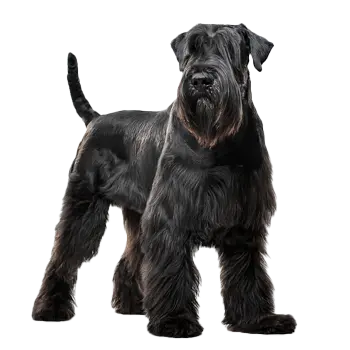The Riesenschnauzer carries a name that directly translates from German as Giant Schnauzer, clearly describing its position as the largest of the three Schnauzer breeds. This German name remains widely used among breed enthusiasts worldwide and serves as the alternate designation for what is officially registered in English-speaking countries as the Giant Schnauzer. Understanding the various names associated with this breed provides insight into its history and the roles it has filled across different eras and regions.
The term Schnauzer itself derives from the German word for muzzle or snout, referencing the breed's distinctive facial features including the characteristic beard, mustache, and bushy eyebrows that define all three Schnauzer varieties. The prefix Riesen means giant or large in German, distinguishing this variety from the Mittelschnauzer (Standard Schnauzer) and Zwergschnauzer (Miniature Schnauzer). In Germany and throughout Europe, the name Riesenschnauzer predominates and appears in official breed registries and documentation.
Historically, the breed was known by several regional names reflecting its working origins in Bavaria. The Munich Schnauzer or Munchener was a common designation during the late 19th and early 20th centuries, acknowledging the breed's popularity and development in and around Munich, Germany. Bavarian cattlemen who encountered Standard Schnauzers at Stuttgart markets and sought to create a larger, more powerful version used this name as they developed what would become the modern Riesenschnauzer.
Other historical names include the Bavarian Wolf Dog or Bavarian Wolf Hund, which appeared in early descriptions from 1876 characterizing these dogs as strong, predominantly black animals with rough or shaggy coats, strong chests, and notable courage in herding livestock and providing protection. The Beer Schnauzer earned its name from the breed's extensive use as guard dogs at Bavarian breweries, where they protected valuable property and inventory throughout the night hours.
In some early German texts, the breed was referenced simply as a rough-coated drover dog or driving dog, emphasizing its function in moving cattle and other livestock to market. The Russerl or Bear Schnauzer designation appeared in early show records, describing dogs with longer, smoother coats that differed from the preferred harsh, wiry texture. These smooth-coated variants eventually disappeared from breeding programs as the standard coat type became established.
The English name Giant Schnauzer became standard in English-speaking countries following the breed's introduction to Britain and America in the early 20th century. This straightforward translation clearly communicates the breed's relationship to the Schnauzer family while indicating its larger size. In official kennel club registrations throughout North America, Great Britain, Australia, and other English-speaking nations, Giant Schnauzer serves as the recognized breed name.
Casual references among breed enthusiasts often shorten the name to simply Giant when context makes the full breed designation unnecessary. This shorthand appears frequently in conversations among breeders, exhibitors, and owners who are clearly discussing the breed. Similarly, Schnauzer alone may be used when the specific variety is understood from context, though this can create confusion given the three distinct Schnauzer breeds.
The breed's working heritage as a police and military dog has sometimes earned it informal designations related to these roles. In Germany, where the Riesenschnauzer served extensively with police forces beginning in World War I, the breed developed a reputation as an elite working dog alongside the German Shepherd. This professional recognition contributed to the breed's image as a serious, capable working dog rather than merely a companion breed.

